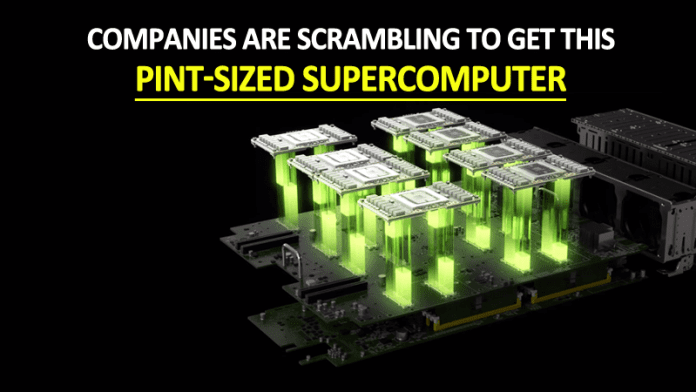Seems little, right? But it is not. We are talking about a supercomputer with an official price of US $129 thousand. Pricey, very expensive. There are cheaper supercomputers on the market, and if a company decides to set up its own machine to work with artificial intelligence, it will probably have fewer costs. Even so, the DGX-1 is making beautiful in sales (for such a costly equipment). Basically, the DGX-1 is a complete solution for artificial intelligence, both hardware, and software. When we talk about it, a room full of servers comes to mind. But the DGX-1 is a small machine, smaller than desktops, and at first glance it makes us think of a module that increases data center processing or data storage. But the size does not matter. If you open a DGX-1, there you will find within eight powerful Tesla GPUs P100 (Pascal architecture), each with 16 GB of memory HBM2. The device also has two Intel Xeon processors, 512 GB DDR4 memory, four SSDs 1.92 TB RAID and power supply 3,200 W. The operating system, a version of Ubuntu Server, is already accompanied by deep learning software and development tools, just to give you an idea. The package is complemented by technologies such as NVLink, which allows GPUs to communicate very quickly, avoiding bottlenecks that would exist, for example, if the third-generation PCI Express interface was used.
In performance, a single DGX-1 can reach the 170 teraflops mark (in FP16). Even, the small supercomputer Nvidia has been used successfully in very complex applications. The MIT Technology Review explains, for example, the Argonne and Oak Ridge laboratories are using the DGX-1 to search for the causes of cancer and thereby develop effective therapies against disease. Both surveys are part of the Moonshot, an initiative that the vice president of the United States Joe Biden created (after losing his son due to cancer) in order to make laboratories and research centers work together. Fidelity Labs employs the supercomputer in research that attempts to create neural networks that mimic the human brain with maximum precision. Another example comes from SAP, which is using the DGX-1 in units of Germany and Israel to develop machine learning software to customers. Overall, what has attracted companies in many industries is not only the processing power of the DGX-1 but also its “call, use” style proposal. Well, it’s not like that, but because the device is ready for use in artificial intelligence applications, companies spend much less time configuring servers, installing systems, tuning software, and so on. Everything indicates that it is only the beginning. Nvidia plans to launch other supercomputers for artificial intelligence as early as 2017, although it has not given details on the specifications of such equipment. But I bet on more account versions. If the DGX-1 does not disappoint in sales even if it costs a fortune, one can imagine how successful the company will be if it makes available more affordable models that could, for example, meet the needs of small businesses or startups.


